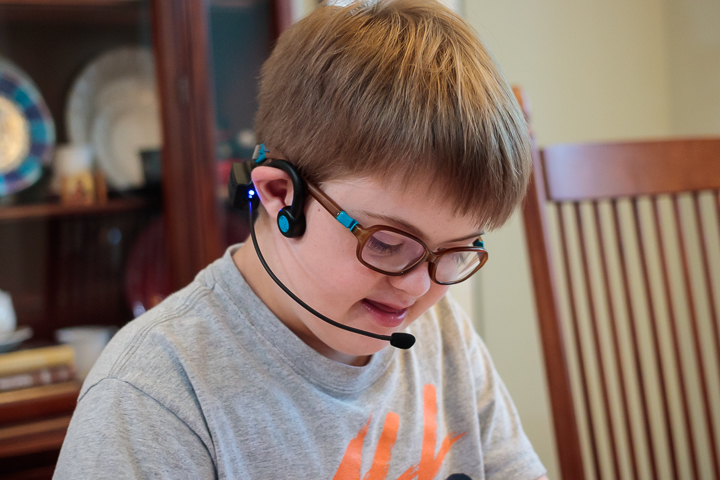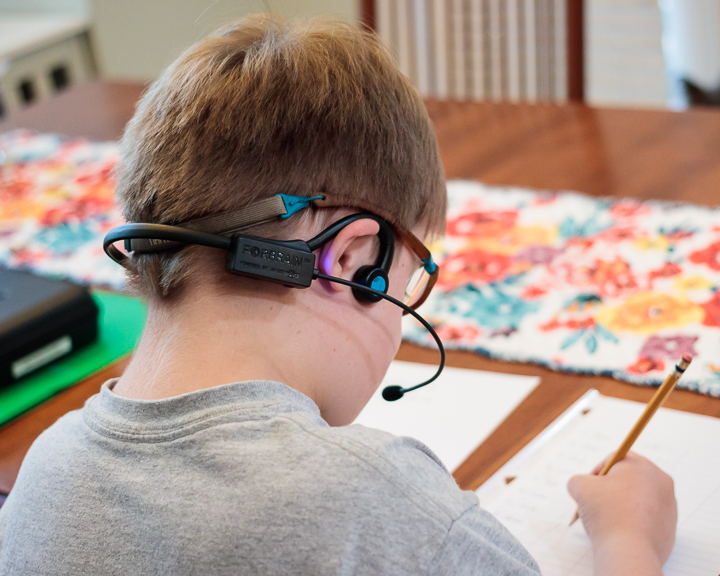
Nathan doesn’t talk if he thinks he won’t be understood.
Mr. Andi, Sarah Kate, and I usually understand what he means (Sarah Kate is particularly expert in deciphering his intent), so he talks our ears off at home but is often quiet in public. We are familiar with which sounds are tough for him, so if a word isn’t clear it’s easier for us to figure out what the word is supposed to be (a simple example would be the “l” sound: “look” becomes “wook”).
For years, I wondered if a big part of Nathan’s problem was not hearing words correctly.
Often, he would say a word, we would correct his pronunciation, he would nod in agreement, and then he would repeat the word but without correcting the pronunciation – as if the way he said it and the way we said it sounded the same to him.
A few months back, I was contacted by a representative of Sound for Life, wondering if I would be interested in a partnership involving their Forbrain product, a multisensory headset that they claimed was designed to improve speech, memory, and attention. I’ll be honest – I had very low expectations. To improve speech production in young kids, the company recommended beginning with a six-week protocol of reading aloud for 10-15 minutes per day while wearing the headset – barely any effort at all.
A device that could improve his speech just by reading for a few minutes each day when he’s been going to private speech therapy for YEARS? C’mon. No way.
I consulted Nathan’s speech therapist and also spoke with a client of mine who is a speech therapist and pediatric therapy clinic director. Neither of them was familiar with Forbrain but both told me to go for it – what would we lose except for a little time?

We started using it on the first of August. On the first day, I couldn’t believe it – he already sounded better at the end of ten minutes. In fact, when I say I couldn’t believe it, I mean that I actually DID NOT BELIEVE IT. I had Mr. Andi try it with him, without telling him how the session had gone. He was just as astonished as I was. I took it to his next speech therapy appointment, and the reaction from his therapist was similar to ours.
Forbrain was working.
The big question, of course, was whether the improvements would carry over when he wasn’t wearing the headset. At first, I wasn’t sure if it was working, but it didn’t take long to notice improvements in his speech production. Here’s an example: Nathan loves Monster Jam trucks, and sometimes a Forbrain session was simply reading off the names of all the Monster Jam trucks on a small poster that we keep folded up in the Forbrain case. Within a few days, he went from saying something that sounded like “Simuhn Cuhss” to “Captain’s Curse” – and he hasn’t said “Simuhn Cuhss” again, even when he isn’t wearing the headset.

We continued the daily reading sessions and using it for a few minutes during each therapy session. A couple of weeks after school started, I sent it in his backpack and asked his special education teacher to have him use it during reading at school. He also began using it while doing his reading and spelling homework at night.
With each passing day, his speech continues to improve.
Speech and language development is a challenge for most kids with Down syndrome, mainly due to their anatomy. They tend to not only have lower muscle tone, meaning they have to work harder to produce sounds, but their mouths are also structured a bit differently – hence Nathan’s struggle with the “l” sound. In addition to these issues with forming sounds, they also have narrow Eustachian tubes that affect how they hear different tones.

If Nathan can’t hear a word correctly, how can he learn to say it correctly?
The answer: listening isn’t limited to our ears – our bones transmit sound, as well, and that’s the key to why Forbrain works for Nathan.
I’ve been a runner for many years, and several of my running friends use Aftershokz bone conduction headphones so they can listen to music but still hear sounds around them (like cars or dogs). Forbrain uses the same technology and adds a small, flexible, microphone and a filter that enhances specific frequencies used in speech.

Forbrain allows Nathan to hear his own voice through bone conduction, rather than through his ears. He can hear and correct his pronunciation in real time – and he does. He also enjoys using it – when he first got his glasses, I was concerned about keeping them on him, but it was never an issue because he could see better so he wanted to wear them. Using Forbrain is the same way – he loves hearing his voice more clearly.
As I said above, Nathan’s private speech therapist was impressed. She has since told me she wants to purchase a unit for another patient she treats. The speech therapist at Nathan’s school is looking into acquiring three for the school. And you know what? They should be able to do it because Forbrain is actually affordable! AAC systems and other speech technologies typically run in the thousands of dollars (ALL adaptive and therapeutic equipment is expensive, for that matter); Forbrain is only a little bit more than what my running friends’ paid for their Aftershokz.

And it’s not just our family, teachers, and therapists who have noticed a difference.
As I was finishing up this post over the weekend, Mr. Andi and I were out in the yard. Our neighbor was driving by and stopped to chat for a minute. His son, who is Nathan’s age and is in his mainstream class at school, was in the front seat. We chatted for a few minutes and then his son piped up, “Miss Andi, Nathan has come a long way since school started. He is talking a lot more with everyone in the class.” My heart soared! Nathan’s classmate had no idea about the Forbrain headset, but even he had noticed that Nathan was talking a lot more – and he talks a lot more when he believes he will be understood.
Forbrain has been a gamechanger.
If you’re interested in learning more about Forbrain, I’m happy to answer any questions you have about our experience, or you can visit the Forbrain website for more information (including info about how it can positively impact attention and memory, as well). My readers can also receive a 10% discount on a Forbrain unit by clicking on this link.
As noted above, Forbrain sent me a unit free of charge to try, with no guarantee that I would write a positive review or promote the unit in any way. I was so impressed with the device that I reached out to the company before publishing this post to ask if they would be willing to provide my readers with a discount code – they generously complied and also invited me to be part of their affiliate program (normally open only to professionals).

So cool!
This bone conduction has new powers and new possibilities.
Getting much more accurate feedback.
And it’s always good when a classmate has that flashbulb moment.
Love to read this about Nathan! His smile has always been his charm, but to know now that he is able to communicate better with his peers must bring his confidence up (and yours too!)